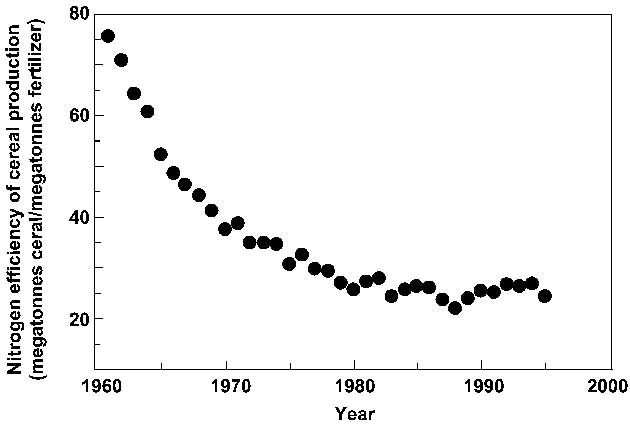The breeding and dissemination of Modern Varieties (MV) has had a major impact on food production.
Goals |
Certainty |
Rs |
Range of Impa |
acts |
Scale |
Wide |
Specificity |
The breeding and dissemination of Modern Varieties with greater yield potential, better pest and disease resistance and improved organoleptic quality have, in conjunction with irrigation, fertilizer, pesticides and mechanization, had a major impact on food production (Figure 3-1). Modern Varieties, especially of cereals but also of root, protein and horticultural crops, have been widely adopted; Asia grows modern cereal varieties on 60-80% of the cultivated area (Evenson and Gollin, 2003a). Modern Varieties are also widely grown in Latin America but there has been less impact in sub-Saharan Africa and CWANA. Other than in CWANA there has been little impact of Modern Varieties on protein crops (mostly annual legumes).
Evidence relating farm size to productivity and efficiency is weak.
Goals |
Certainty |
Range of Impacts |
Scale |
Specificity |
Farms operated by small-scale producers are typically more efficient the smaller they are (Feder et al., 1988; Place and Hazell, 1993; Deininger and Castagnini, 2006). However, in large-scale mechanized farming economies of scale are important. For example, some regionally specific research has concluded that productivity and efficiency are positively related to farm size (Yee et al., 2004; Hazarika and Alwang, 2003), although there is also evidence that some large-scale mechanized farms are less efficient than smaller family farms (Van Zyl, 1996). The lack of clarity about the relationship between farm size and productivity and efficiency (Sender and Johnston, 2004) suggests confounding factors, such as land quality, and access to labor, markets, sources of credit and government farm policies (Van Zyl, 1996; Chen, 2004; Gorton and Davidova, 2004). For example, land per capita has been found to be a major determinant of overall household income (Jayne et al., 2003). Good management, on large- and small-scale farms, may be the most important factor affecting production efficiency. Typically, largescale farmers with financial resources intensify agrichemical inputs and seek economies of scale, while resource-poor small-scale farmers reduce inputs, diversify, and seek risk aversion (Leakey, 2005a). Interestingly, it is often among the latter group that some of the best examples of sustainable agriculture are found, especially in the tropics (Palm et al., 2005b).
Globally there has been an extensive increase in irrigated areas, but investment trends are changing.
Since 1961, the area of irrigated land has doubled to 277 million ha (in 2000)-about 18% of farmed land, funded initially by investments by international development banks, donor agencies, and national governments but later
increasingly by small-scale private investments. Irrigation was essential to achieving the gains from high-yielding fertilizer-responsive crop varieties. Approximately 70% of the world's irrigated land is in Asia (Brown, 2005), where it accounts for almost 35% of cultivated land (Molden et al., 2007a). Forty percent of the world cereal production is from irrigated land and as much as 80% of China's grain harvest comes from irrigated land. By contrast, there is very little irrigation in sub-Saharan Africa. Trends have changed from the 1970s and early 1980s when donor spending on agricultural water reached a peak of more than US$1 billion a year. Funding fell to less than half that level by the late 1980s; benefit-cost ratios deteriorated; and as falling cereal prices and rising construction costs highlighted the poor performance of large-scale irrigation systems, opposition mounted to the environmental degradation and social dislocation sometimes caused by large dams. Today, there appears to be consensus that the appropriate scale of infrastructure should be determined by the specific environmental, social, and economic conditions and goals with the participation of all stakeholders (Molden et al., 2007a).
Increased fertilizer use is closely associated with crop productivity gains in regions that have been most successful at reducing undernourishment.
Goals |
Certainty |
Range of Impacts |
Scale |
Specificity |
On a global scale, total fertilizer consumption has increased from approximately 31 million in 1961 to 142 million tonnes in 2002 (FAOSTAT, 2007). From almost no use in the early 1960s, total fertilizer consumption rates in the developing countries of Asia (140 kg ha -1 yr -1) now exceed those in industrialized nations (FAOSTAT, 2006) and have been a principal driver of improved crop productivity. In sub- Saharan Africa where cereal productivity has increased only modestly since the 1960s, average fertilizer consumption remains exceptionally low-under 20 kg ha-1 yr -1 (FAOSTAT, 2006). For cereal crops, approximately 50% of the yield increases observed after the introduction of modern crop

Figure 3-3. Trend in nitrogen fertilizer efficiency of crop production calculated as annual global cereal production/annual global application of N. Source: Tilman et al., 2002.